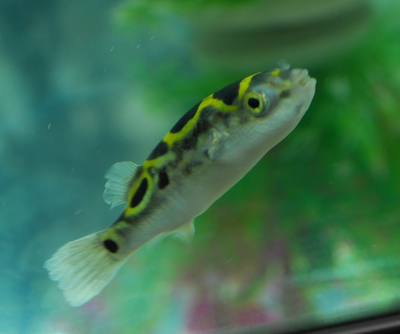Figure 8 Pufferfish
Posted by Max Gandara on on 7th Aug 2024
Figure 8 Pufferfish: The Colorful and Curious Aquarium Resident
Figure 8 Pufferfish, known scientifically as Tetraodon biocellatus, are a delightful and intriguing addition to any aquarium. With their vibrant colors, playful nature, and distinctive patterns resembling the number 8, these pufferfish are sure to capture the hearts of aquarists. This blog will delve into the world of Figure 8 Pufferfish, covering their origin, care requirements, tank setup, feeding, breeding, and common health issues.
Origin and Characteristics
Figure 8 Pufferfish are native to the slow-moving rivers, estuaries, and coastal waters of Southeast Asia, including regions in Thailand, Malaysia, and Indonesia. They are named for the characteristic patterns on their backs, which resemble the number 8. These pufferfish typically grow to about 3 inches in length and are known for their intelligent and curious behavior.
Tank Setup and Environment
Creating the perfect environment for Figure 8 Pufferfish involves careful planning and specific conditions:
- Tank Size: A minimum of 15 gallons is recommended for a single pufferfish. If you plan to keep more than one, a larger tank is necessary to prevent territorial disputes.
- Water Parameters: Figure 8 Pufferfish thrive in slightly brackish water with a specific gravity of 1.005 to 1.008. Maintain a temperature between 78°F and 82°F, and a pH level of 7.5 to 8.0.
- Filtration and Water Quality: Use a high-quality filter to maintain excellent water quality. Regular water changes (about 25% weekly) are crucial to keep the environment clean and stable.
- Substrate and Decorations: Use a sandy or fine gravel substrate. Provide plenty of hiding spots with rocks, driftwood, and plants (both live and artificial) to mimic their natural habitat and reduce stress.
Feeding Figure 8 Pufferfish
Figure 8 Pufferfish are carnivorous and have specific dietary needs that must be met to ensure their health:
- Varied Diet: Feed them a variety of foods such as bloodworms, brine shrimp, snails, and krill. Hard-shelled foods like snails are essential to help wear down their continuously growing teeth.
- Frozen and Live Foods: Incorporate both frozen and live foods into their diet to provide necessary nutrients and stimulation.
- Feeding Frequency: Feed them once or twice a day, providing only as much as they can eat within a few minutes to avoid overfeeding and maintain water quality.
Breeding Figure 8 Pufferfish
Breeding Figure 8 Pufferfish in captivity is rare and challenging, but with the right conditions, it can be achieved:
- Breeding Pair: Ensure you have a compatible male and female pair. Males are typically slimmer and more colorful than females.
- Breeding Tank: Use a separate breeding tank with slightly warmer water and plenty of hiding spots. Provide a sandy substrate where the female can lay her eggs.
- Spawning: Condition the pair with high-quality live foods. The female will lay eggs on the substrate, and the male will fertilize them. After spawning, remove the adults to prevent them from eating the eggs.
- Fry Care: Once the eggs hatch, feed the fry with infusoria or commercially available fry food. As they grow, gradually introduce them to larger foods like brine shrimp nauplii.
Common Health Issues
Figure 8 Pufferfish are generally hardy, but they can be susceptible to certain health problems if their environment and diet are not well-maintained:
- Ich: A common parasitic infection. Treat with ich-specific medication and maintain stable water conditions.
- Fin Rot: Often caused by poor water quality. Treat with antibacterial medication and improve tank hygiene.
- Dental Issues: If not provided with hard-shelled foods, their teeth can overgrow, leading to eating difficulties. Regularly feed them snails or other crunchy foods to prevent this.
Figure 8 Pufferfish are a vibrant and captivating species that bring color and personality to any aquarium. Their unique appearance and playful behavior make them a favorite among aquarists. With proper care and attention, these pufferfish can thrive and provide endless enjoyment for their owners. Whether you are a seasoned aquarist or a beginner, adding a Figure 8 Pufferfish to your tank is a rewarding and delightful experience.

